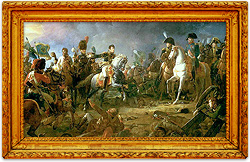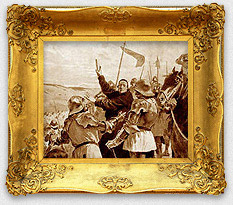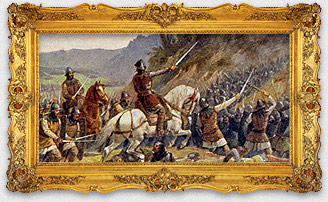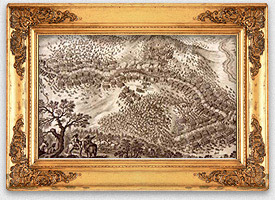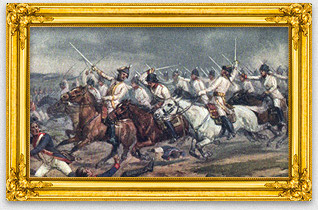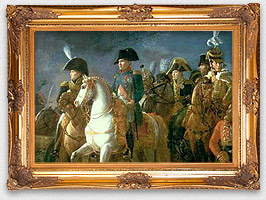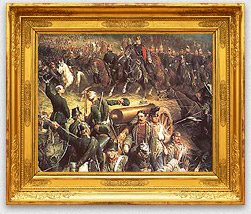Historical Context
The Battle of Austerlitz is one of the most important clashes of the Napoleonic Wars, which Napoleon Bonaparte considered to be his greatest victory ever. The battle took place in Moravia not far from today’s Austerlitz (Slavkov u Brna) in the early December 1805 and not only was this the defeat of the Third Coalition against France but it also brought stabilization of the French power and dominant position within the continent.
The French Revolution, no matter how bloody, unjust, driving wedges between various social classes, destroying or raping other schools of thoughts and the old order, outwardly declared the slogan liberty, equality, fraternity. These thoughts, originally uttered by some of the French philosophers, managed to get into the thinking of some scholars as well as the common people and they keep their influence until today.
At the beginning of the 19th century, however, these were for many of the old regimes extremely dangerous and that is why anything connected with them was suspicious and unwanted within the home area. The same situation was in Austria. The spreading of these revolutionary thoughts was not thanks to the French Revolution, it was rather its “descendent” – Napoleon Bonaparte, by many an admired commander, by many a damned tyrant.
The strong armies with which Napoleon went through Europe so many times brought not only destruction and economic burden but also many new thoughts. Yet, it is impossible to clearly say that these proclaimed slogans had only positive influence. What can be said for sure is that they changed Europe, besides other things also because they were the initial trigger for nationalism. It was also in the Bohemian Lands where as a result of the campaign in 1805 the importance of the nation in the social thinking got stronger and was clearly defined.
This is how the circumstances linked to the Battle of Austerlitz influenced the development of the modern Czech national movement. Napoleon Bonaparte came to power gradually at the end of the 18th century when he distinguished himself as an excellent commander in fights against Austria, Britain, some Apennine lands or Mameluck Empire in Egypt. In 1804 he even declared himself an emperor, which was an unparalleled act as until that time there was only one emperor in Europe – the sovereign of the Holy Roman Empire.
This position had been kept for centuries by Austrian Habsburgs and therefore it is of no surprise that Napoleon’s coronation brought even more animosity between France and Austria. With this Napoleon also fully openly showed how much he longed for even more power and strength of France. Another anti-French coalition was slowly coming to life and everything was once again taking the direction to another war.
Preceding Events
Coalition number three aimed against France was made by union of Great Britain, Austria and Russia. Napoleon was aware of the fact that his priority was to weaken Britain and therefore he was preparing the landing of his armies in England. However, Britain was the naval power number one and the French navy could not compete them.
Napoleon was aware of that and therefore he took actions to lure the British navy from the Channel. He concentrated his forces at Boulogne and on the shores of the Channel and was waiting for his opportunity. However, because of the newly arisen coalition he was forced to leave the North of France and move his army towards the East in order to stop the uniting of the Austrian and Russian troops. The marching of his soldiers was so fast that he surprised the Austrian army under the command of General Mack near Ulm in southern Germany and cut them off the paths of retreat. Mack’s army sent to the front in order to slow down the potential French attack was literally overpowered with French soldiers’ feet, as they themselves liked making jokes about that. In total 60,000 out of 72,000 men of the Austrian army was largely captured or deserted.
At the same time, however, the united French-Spanish nave was defeated in the naval Battle of Trafalgar which meant losing the last chance to defeat Great Britain with landing on their territory. After that Napoleon conquered Vienna without fighting, but in that time the Russian army under the command of Marshal Kutuzov arrived in Moravia in order to join the remaining Austrian army.
The French emperor intended to provoke a single deciding battle against the Austrian-Russian forces because from the long-term point of view the situation for him was not advantageous. What was good for him was the fact that the Russian Tsar Alexander I rushed into the battle which did not really enthuse Marshal Kutuzov. This is why it came to a battle which today is also called the Battle of the Three Emperors where the first of them was Emperor Napoleon, the second Emperor Franz and the third Tsar Alexander. The armies met at the beginning of December 1805 on the area to the South of Brno.
Course of the Battle of Austerlitz
Napoleon intended to lure the enemy into the battle no matter what and that is why he withdrew and abandoned for them the better position on Pratec Hills. It did not take him long to prod the Russian command. The French Emperor thought the whole situation through very well. He was expecting to be attacked on his right wing, which was quite logical concerning the terrain and the layout of the ally’s forces. He, however, secured this wing only with a smaller part of his troops and left the major part in the middle of the squad as a reserve for a counter-attack. The exact number of the men on both sides can be only estimated. The French forces amounted to about 70,000 to 75,000 men and the Russian-Austrian about 90,000, clearly the allies outnumbered the enemy only a little bit.
The French were quite lucky at the beginning of the battle of Austerlitz. Their forces laid out behind the brook Zlatý potok were in the morning covered with a thick fog which was fading only slowly. Napoleon, however, had a good view from the Hill of Žuráň of the four Austrian and Russian offensive c convoys coming from Pratec Hills which were rolling down on the southern part of his squad. These had no idea about the layout of the enemy thanks to the thick fog.
But this time everything depended on the resistance of the French southern wing and also on the fact if the troops of the general Davout being late would get to the battlefield on time. Davout’s soldiers marched even during the night so that they would come on time for the battle. But Five Austrian and Russian offensive convoys had to since 7.00 (they reached the enemy at about 8.00) manage several kilometres of fields and meadows before they reached the enemy. This succeeded at Sokolnice and Telnice to take an advantageous position such as e.g. chateau in Sokolnice and the adjacent game park and mustering all their strengths and with help of the Davout’s troop they managed to fight of the outnumbered offensive convoys (about 12,000 French against 40,000 allies).
In the meantime, the southern part of the allied army was fully occupied with the offensive action, Napoleon was preparing the decisive counter-attack. Because of the fact that one half of the Russian-Austrian army moved towards the middle of the squad to the south Pratec hills nearly completely cleared out. The Emperor Napoleon sensed the right time for launching the attack. At 9.00 two divisions started the attack. At first the divisions, covered in fog, were moving towards the middle of the ally’s squad. A part of the late fourth offensive convoy was fighting back but after an hour of fighting they were defeated. Their fate was followed by a whole range of elite troops from the allies’ reserves such as tsarist guard. Two landmarks – the Hill of Pratec and the Vineyards were slowly getting into the hands of the French.
Meanwhile on the northern part of the frontline a side attack of the allies’ forces was being led along the road stretching between Brno and Olomouc. This was, according to the plan, supposed to attract most of the French forces and to try to potentially drive them back towards Brno. Their attempts, however, failed thanks to the grapeshots of the artillery from the Hill of Santon not far from Žuráň where Napoleon had his position. The clash of about 12,000 riders of both belligerents there ended in a draw. It was the French attack, called by the French army commander “a lion’s jump”, that was the most important. The captured Old Vineyards and the Hill of Pratec became several times a place of a desperate attempt of the Russian and Austrian troops to turn the tide of the battle. Yet all of them failed.
At this phase of the battle of Austerlitz, Napoleon decided to attack from the heights towards the South and to cut off the still fighting allies’ offensive convoys at Sokolnice and Telnice. The attack in this direction started at about 2.00 PM. Russians and Austrians tried to slow down the enemy’s enhancement, but at that point everything was actually decided, and their attempt was soon dashed. The withdrawing troops had to even cross frozen ponds – Žatčanský and Mělnický, which later resulted in the legends on masses of Russian soldiers who drowned during this fast withdrawal.
Archaeological research carried out later proved that there were only a few men who drowned in the ponds. The ponds at the rear of the fleeing troops helped as a natural barrier to spread chaos and to increase the losses on the side of the allies, though. What saved the rest of the fleeing formations was a wrong estimation of the French command assuming that the enemy would be withdrawing towards Olomouc. But Russian-Austrian forces according the decision which was made before the start of the battle chose as a path of retreat in the direction of Hodonín. The losses were especially on the side of the allies huge.
Approximately 15,000 men were killed or injured and some further 12,000 were captured. To that it is also necessary to count the loss of 180 precious canons. The French lost 1,389 dead, 7,260 injured and several hundreds of captured.
Result of the Battle of Austerlitz
Napoleon was aware of the extent of his victory, but also of the fact that in broader surroundings there were a lot of undefeated armies and it was not quite clear what the reaction of Prussia would be. That is why he decided to gain as much as possible from his great victory rather than to risk and try to destroy further Austrian and Russian forces. Already two days after the battle he met near Spálený mlýn near Uhřice the Emperor Francis I in order to make a truce. The peace treaty was signed on 26th December in Bratislava.
Historical Importance
The defeat was worse for Austria, which had to give up some parts of its areas on the Apennine peninsula, some parts of its Bavarian territory in favour of the French ally and especially it, for the first time, lost its influence in the Holy Roman Empire of the German Nation, which thanks to the policy of the French emperor ceased to exist in the following year. Napoleon replaced it with the Confederation of the Rhine, which was loyal to him and which created a bumper line against the enemies of France.
Austria later tried to get its original role back on the area of today’s Germany, but it was successful only partially because it had to fight for this position with Prussia. The role of Austria, however, was shaken and it was very difficult to get to its original role back. Among other Napoleon’s requirements there were also huge financial reparations which Austria should pay to France. In total it was 140 million francs which were supposed to compensate the distressing state deficit of France, which was also one of Napoleon’s aims at the beginning of the war.
Napoleon’s victory in the Battle of Austerlitz helped France to gain a dominant position until the campaign to Russia. The Russian tsar said after the battle that all rules in Europe are only children in hands of a giant, by whom he meant the French emperor.
Author: Mgr. et Mgr. Jan Rája



